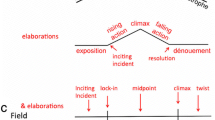Abstract
In the thirteenth-century Old Occitan romance Le Roman de Flamenca (Flamenca), the narrator’s function is complicated when a number of characters (whom I call narrating characters) appropriate the narratorial role by disrupting and manipulating the text using very specific literary techniques. The characters disseminate the plot, address moral issues, dramatize digressions, create imaginary dramatic scenarios, predict events, and address the audience directly. On a number of occasions, these narrating characters act “out of character,” appropriate the authorial voice (and its attendant authority) and add their own subjectivities. Based on the mirroring that occurs between the narrator and the narrating characters, we should consider Flamenca as a multi-narratorial text and treat the narrator as an important character rather than privilege him as representing the authorial voice.
Similar content being viewed by others
References
Grigsby J. L. (1980). The ontology of the narrator in medieval French romance. In G.-G. Minnette & R. F. Jones (Eds.), The nature of medieval narrative (pp. 159–71). Lexington, Ky: French Forum P.
Kay, S. (1979). The use of time in the romances of Jaufre and Flamenca. Medioevo Romanzo, 6, 37–62.
Kay, S. (1990). Subjectivity in Troubadour poetry. Cambridge: Cambridge UP.
Limentani, A. (Ed.). (1965). (Las Novas Guillem de Nivers (“Flamenca”). Vulgares Eloquentes, Vol. 1. Padoue: Antenore.
Rogier, P. (1976). Ges non puesc en bon vers fallir. In D. E. T. Nicholson (Ed.), The poems of the Troubadour Peire Rogier. Manchester: Manchester UP.
Sankovitch, T. (1976). The romance of Flamenca: The puppeteer and the play. Neophilologus, 60, 8–19.
Solterer, H. (1985). Sermo and Juglar: Language games in Flamenca. In G. S. Burgess & R. A. Taylor (Eds.), Court and poet: Selected proceedings of the fourth international conference of the Courtly Literature Society (Toronto, 1983). Woolbridge, pp. 330–338.
Stebbins, C. E. (1976). L’inspiration possible de Marcabru relativement aux thèmes du bon vieux temps et de la déchéance morale du monde dans Flamenca. Revue des Langues Romanes, 182, 185–197.
Acknowledgements
I would like to thank Linda M. Paterson, Douglas Kelly, Donald W. Rowe, Sherry L. Reames, and Nick Doane for their valuable comments.
Author information
Authors and Affiliations
Corresponding author
Rights and permissions
About this article
Cite this article
Grossweiner, K.A. Narrators and Narrating Characters: Voicing in Le Roman de Flamenca . Neophilologus 92, 395–408 (2008). https://doi.org/10.1007/s11061-007-9067-7
Received:
Accepted:
Published:
Issue Date:
DOI: https://doi.org/10.1007/s11061-007-9067-7




